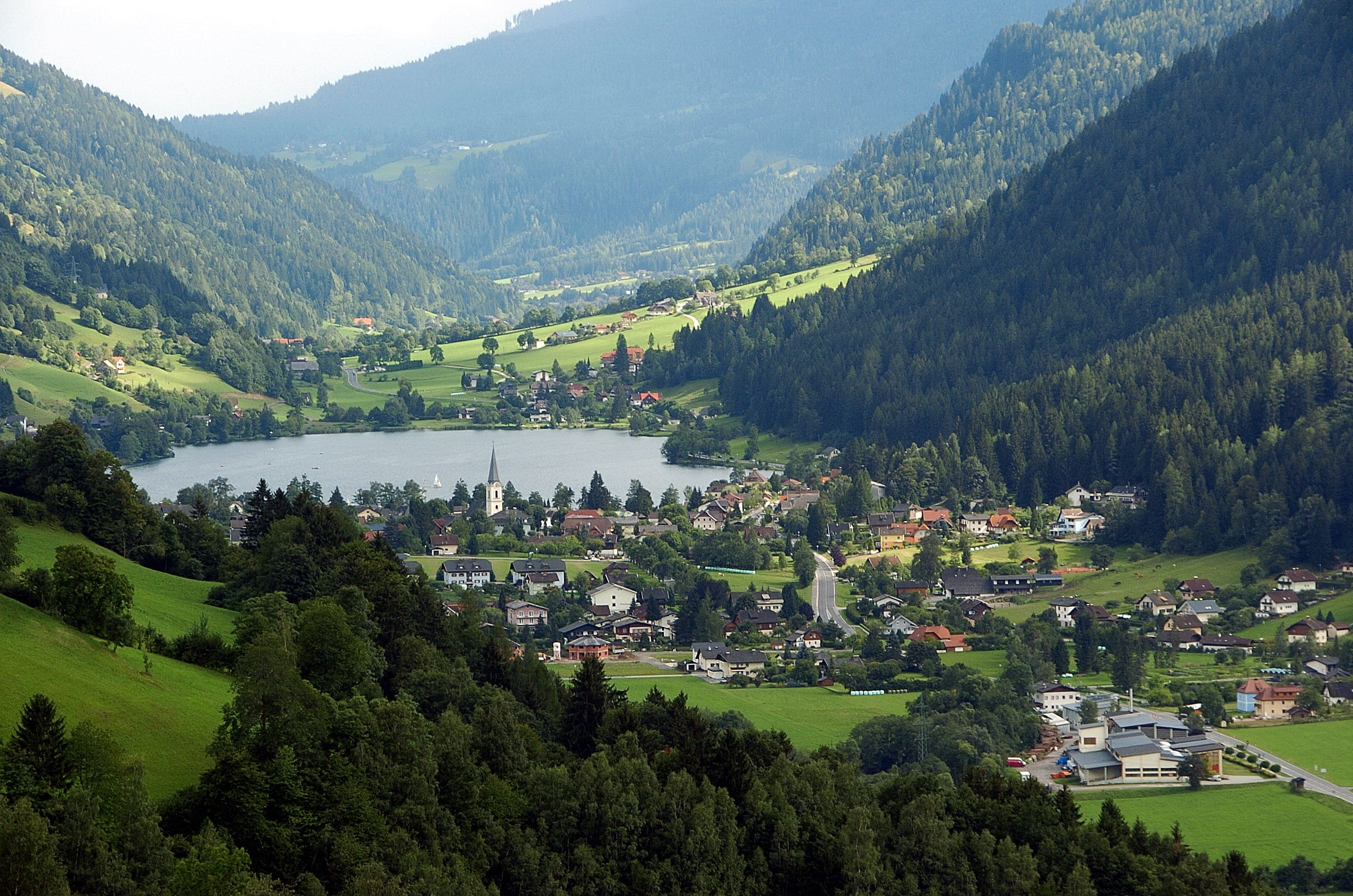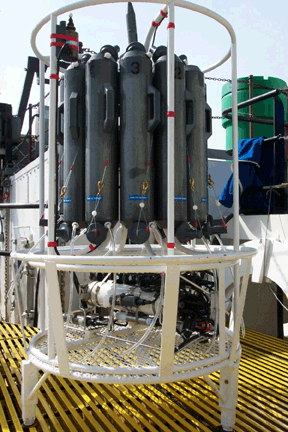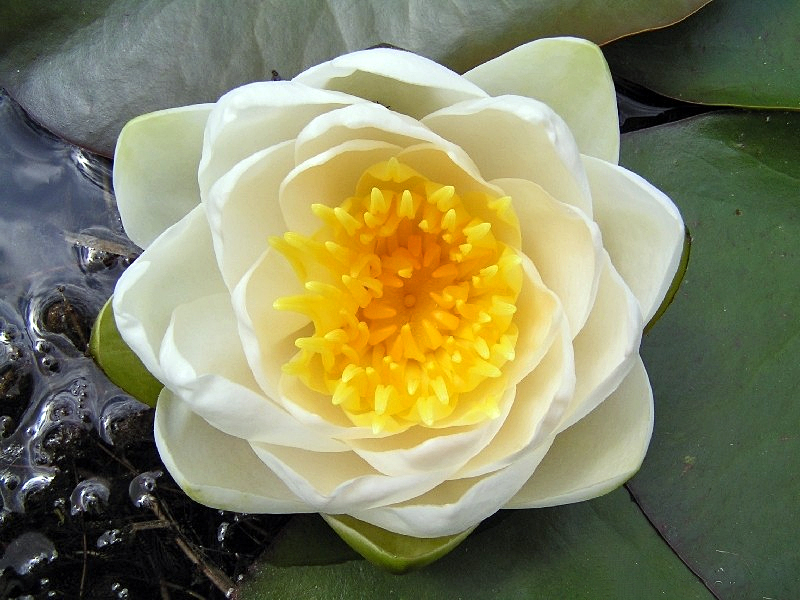|
Brennsee
Brennsee, also called Feldsee, is a lake in Carinthia, Austria. Geography It is situated at 739 metres above the Adriatic (2,425 ft), in the Gegendtal Valley, running from east to west through the Gurktal Alps (Nock Mountains) range. The shaded steep slopes of the Mirnock massif in the south are covered with forests, while the northern shore is settled with Alpine pastures and farmsteads. Brennsee is entirely located within the Feld am See municipal area. Limnology The lake is mainly fed by ground water and by several small brooks in the north. At the western end of the lake a short stream dewaters the water into the Kleinkirchheimer Bach, which itself flows into Millstätter See (as Riegerbach) at Radenthein-Döbriach. The holomictic waters reach in summer. The surrounding settlements are connected to a sewerage system since the 1970s, nevertheless agricultural discharge has proven to be problematic, leading to eutrophication with an overabundance of aquatic plant ... [...More Info...] [...Related Items...] OR: [Wikipedia] [Google] [Baidu] |
Carinthia (state)
Carinthia (german: Kärnten ; sl, Koroška ) is the southernmost Austrian state, in the Eastern Alps, and is noted for its mountains and lakes. The main language is German. Its regional dialects belong to the Southern Bavarian group. Carinthian Slovene dialects, forms of a South Slavic language that predominated in the southeastern part of the region up to the first half of the 20th century, are now spoken by a small minority in the area. Carinthia's main industries are tourism, electronics, engineering, forestry, and agriculture. Name The etymology of the name "Carinthia", similar to Carnia or Carniola, has not been conclusively established. The ''Ravenna Cosmography'' (about AD 700) referred to a Slavic "Carantani" tribe as the eastern neighbours of the Bavarians. In his '' History of the Lombards'', the 8th-century chronicler Paul the Deacon mentions "Slavs in Carnuntum, which is erroneously called Carantanum" (''Carnuntum, quod corrupte vocitant Carantanum' ... [...More Info...] [...Related Items...] OR: [Wikipedia] [Google] [Baidu] |
Sewerage
Sewerage (or sewage system) is the infrastructure that conveys sewage or surface runoff (stormwater, meltwater, rainwater) using sewers. It encompasses components such as receiving drains, manholes, pumping stations, storm overflows, and screening chambers of the combined sewer or sanitary sewer. Sewerage ends at the entry to a sewage treatment plant or at the point of discharge into the environment. It is the system of pipes, chambers, manholes, etc. that conveys the sewage or storm water. In many cities, sewage (or municipal wastewater) is carried together with stormwater, in a combined sewer system, to a sewage treatment plant. In some urban areas, sewage is carried separately in sanitary sewers and runoff from streets is carried in storm drains. Access to these systems, for maintenance purposes, is typically through a manhole. During high precipitation periods a sewer system may experience a combined sewer overflow event or a sanitary sewer overflow event, which forces untrea ... [...More Info...] [...Related Items...] OR: [Wikipedia] [Google] [Baidu] |
Common Rudd
The common rudd (''Scardinius erythrophthalmus'') is a bentho-pelagic freshwater fish, widely spread in Europe and middle Asia, around the basins of the North, Baltic, Black, Caspian and Aral seas. Identification Morphologically, this species is very similar to the roach ('' Rutilus rutilus''), with which it can be easily confused. It can be identified by the yellow eye colour. The eye of the roach has a big red spot above the pupil, that can be more or less conspicuous. The rudd has an upturned mouth allowing it to feed easily at the top of the water. The placement of the dorsal fin is more to the rear which is even visible in very young fish. There are normally only one or two scales between the tip of the pelvic fins and the anal fins, while on the roach there are five. Also the skin of the rudd is yellowish green, while the roach is bluish on the flanks. Also the upturned mouth is visible even in young fish. Furthermore, the rudd's number of soft rays in the dorsal fin (8� ... [...More Info...] [...Related Items...] OR: [Wikipedia] [Google] [Baidu] |
European Perch
The European perch (''Perca fluviatilis''), also known as the common perch, redfin perch, big-scaled redfin, English perch, Euro perch, Eurasian perch, Eurasian river perch, Hatch, poor man’s rockfish or in Anglophone parts of Europe, simply the perch, is a predatory species of the freshwater perch native to Europe and northern Asia. The species is a popular quarry for anglers, and has been widely introduced beyond its native area, into Australia, New Zealand and South Africa. They have caused substantial damage to native fish populations in Australia and have been proclaimed a noxious species in New South Wales. Description European perch are greenish with red pelvic, anal and caudal fins. They have five to eight dark vertical bars on their sides. When the perch grows larger, a hump grows between its head and dorsal fin. European perch can vary greatly in size between bodies of water. They can live for up to 22 years, and older perch are often much larger than average; ... [...More Info...] [...Related Items...] OR: [Wikipedia] [Google] [Baidu] |
Wels Catfish
The wels catfish ( or ; ''Silurus glanis''), also called sheatfish or just wels, is a large species of catfish native to wide areas of central, southern, and eastern Europe, in the basins of the Baltic, Black and Caspian Seas. It has been introduced to Western Europe as a prized sport fish and is now found from the United Kingdom east to Kazakhstan and China and south to Greece and Turkey. It is a freshwater fish recognizable by its broad, flat head and wide mouth. Wels catfish can live for at least fifty years. Etymology The English common name comes from Wels, the common name of the species in German language. ''Wels'' is a variation of Old High German ''wal'', from Proto-Germanic ''*hwalaz'' – the same source as for '' whale'' – from Proto-Indo-European ''*(s)kʷálos'' ('sheatfish'). Description The wels catfish's mouth contains lines of numerous small teeth, two long barbels on the upper jaw and four shorter barbels on the lower jaw. It has a long anal fin tha ... [...More Info...] [...Related Items...] OR: [Wikipedia] [Google] [Baidu] |
Common Carp
The Eurasian carp or European carp (''Cyprinus carpio''), widely known as the common carp, is a widespread freshwater fish of eutrophic waters in lakes and large rivers in Europe and Asia.Fishbase''Cyprinus carpio'' Linnaeus, 1758/ref>Arkive The native wild populations are considered vulnerable to extinction by the International Union for Conservation of Nature ( IUCN), but the species has also been domesticated and introduced (see aquaculture) into environments worldwide, and is often considered a destructive invasive species, being included in the list of the world's 100 worst invasive species. It gives its name to the carp family, Cyprinidae. Taxonomy The two subspecies are: * '' Cyprinus carpio carpio'', native to much of Europe (notably the Danube and Volga rivers)Jian Feng Zhou, Qing Jiang Wu, Yu Zhen Ye & Jin Gou Tong (2003). Genetic divergence between ''Cyprinus carpio carpio'' and ''Cyprinus carpio haematopterus'' as assessed by mitochondrial DNA analysis, with emph ... [...More Info...] [...Related Items...] OR: [Wikipedia] [Google] [Baidu] |
Northern Pike
The northern pike (''Esox lucius'') is a species of carnivorous fish of the genus ''Esox'' (the pikes). They are typical of brackish water, brackish and fresh waters of the Northern Hemisphere (''i.e.'' holarctic in distribution). They are known simply as a pike in Great Britain, Britain, Ireland, and most of Eastern Europe, Canada and the United States. Pike can grow to a relatively large size: the average length is about , with maximum recorded lengths of up to and published weights of . The International Game Fish Association, IGFA currently recognizes a pike caught by Lothar Louis on Greffern Lake, Germany, on 16 October 1986, as the all-tackle world-record northern pike. Northern pike grow to larger sizes in Eurasia than in North America, and typically grow to larger sizes in coastal than inland regions of Eurasia. Etymology The northern pike gets its common name from its resemblance to the pole-weapon known as the Pike (weapon), pike (from the Middle English for 'point ... [...More Info...] [...Related Items...] OR: [Wikipedia] [Google] [Baidu] |
Water Quality
Water quality refers to the chemical, physical, and biological characteristics of water based on the standards of its usage. It is most frequently used by reference to a set of standards against which compliance, generally achieved through treatment of the water, can be assessed. The most common standards used to monitor and assess water quality convey the health of ecosystems, safety of human contact, extend of water pollution and condition of drinking water. Water quality has a significant impact on water supply and oftentimes determines supply options. Categories The parameters for water quality are determined by the intended use. Work in the area of water quality tends to be focused on water that is treated for potability, industrial/domestic use, or restoration (of an environment/ecosystem, generally for health of human/aquatic life). Human consumption Contaminants that may be in untreated water include microorganisms such as viruses, protozoa and bacteria ... [...More Info...] [...Related Items...] OR: [Wikipedia] [Google] [Baidu] |
Algae
Algae ( , ; : alga ) are any of a large and diverse group of photosynthetic, eukaryotic organisms. The name is an informal term for a polyphyletic grouping that includes species from multiple distinct clades. Included organisms range from unicellular microalgae, such as '' Chlorella'', '' Prototheca'' and the diatoms, to multicellular forms, such as the giant kelp, a large brown alga which may grow up to in length. Most are aquatic and lack many of the distinct cell and tissue types, such as stomata, xylem and phloem that are found in land plants. The largest and most complex marine algae are called seaweeds, while the most complex freshwater forms are the '' Charophyta'', a division of green algae which includes, for example, '' Spirogyra'' and stoneworts. Algae that are carried by water are plankton, specifically phytoplankton. Algae constitute a polyphyletic group since they do not include a common ancestor, and although their plastids seem to have a single ori ... [...More Info...] [...Related Items...] OR: [Wikipedia] [Google] [Baidu] |
Aquatic Plant
Aquatic plants are plants that have adapted to living in aquatic environments ( saltwater or freshwater). They are also referred to as hydrophytes or macrophytes to distinguish them from algae and other microphytes. A macrophyte is a plant that grows in or near water and is either emergent, submergent, or floating. In lakes and rivers macrophytes provide cover for fish, substrate for aquatic invertebrates, produce oxygen, and act as food for some fish and wildlife. Macrophytes are primary producers and are the basis of the food web for many organisms. They have a significant effect on soil chemistry and light levels as they slow down the flow of water and capture pollutants and trap sediments. Excess sediment will settle into the benthos aided by the reduction of flow rates caused by the presence of plant stems, leaves and roots. Some plants have the capability of absorbing pollutants into their tissue. Seaweeds are multicellular marine algae and, although their ecologic ... [...More Info...] [...Related Items...] OR: [Wikipedia] [Google] [Baidu] |


_(13532570755).jpg)




